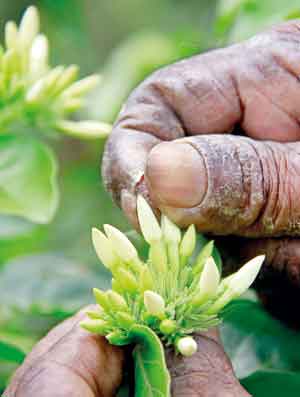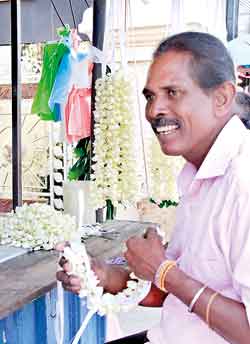Flower power

In search of lotus flowers: Wasantha in his tyre tube. Pix by Indika Handuwala
For Chandana Pushpakumara from Thalawa and W.D. Wasantha from Kesbewa, the lotus is a means of living. Going into murky waters at the crack of dawn on a tyre tube, searching for these beauties is a balancing act of agility. The circumscribed space of the tube is shared by the plucker and the flower. Surprisingly 500 flowers can fit into this space, Wasantha claims. “Unlike the small boats, the lightness of the tube enables one to reach out for the flowers,” says Wasantha who has been in the trade for the past 15 years and his father too before him.
This business entails a sub-culture of its own. Very often the flowers are sourced from lakes which are leased out annually by farmer organisations. The highest bidder claims the lease of a lake and only the pluckers authorised by him are allowed access to the lake. The lease is renewed each year Chandana explains. The distribution channel of the enterprise, works on its own ropes. “Once the flower buds (pohottu) are packed into gunny bags, they are transported to various destinations by the night train, so that they reach by morning and in full bloom,” says Chandana who is a regular supplier to Aluthgama Kande Viharaya, Kalutara Viharaya and Bellanwila Temple for the past 20 years.

Intricate affair: Plucking jasmine buds
“April is the most bountiful season for us,” he says, explaining that Japan jabara or water hyacinth, an aquatic weed and heavy rains are the worst enemies of the lotus flower pluckers. Another common foe is the crocodile, says Chandana. Most of the lakes he wades through in Thalawa and Thambuthegama are also home to crocs.
K.D.D. Priyangika who has been in the flower business near Bellanvila temple, sources her supply of lotus and water lily (manel) from Thalawa, Kekirawa, Padaviya, Nagollagama and Medawachchiya. “We sell about 1000 flowers a day but on poya days the demand is more,” says Priyangika, adding that there is also a demand for weddings, other ceremonial functions and flower wreaths.
Watching his jasmine (pichcha) kiosk close to Wellawatta Kovil going in flames during the 1983 riots, made K. Manoharan (Mano) plant his own patch of jasmine bushes in Mawathagama, where his ancestral roots lie. His 20-perch jasmine plot of Mawathagama, off Kurunegala, envelops a visitor in a scent like none other. As Mano himself admits, “the fragrance is intoxicating at times.” Together with wife Nageshwari who is known more as ‘Kumudu’ in a flowery spirit, Mano tends to his jasmine cultivation with reverence. “Jasmine has several varieties and what we grow is pokuru pichcha often used for garlands,” explains Mano who is a well- known name among flower sellers near the Kandy Dalada Maligawa and Wellawatta Kovil, as he supplies flowers to them.

Fragrant corner in bustling Wellawatte: Manoj Kumara at his jasmine kiosk
A jasmine bush takes five to six months to reach maturity and a well-tended bush can have a long life span. Mano’s jasmine plot yields around four kilos of buds a day. “Until they grow, they need to be looked after like babies,” says Mano fondly, pointing at some older bushes with a chuckle: “these are of course like me, gnarled now.” For a bountiful crop, the bushes require basic fertilizer of nil keta every three to four months coupled with pruning. Similar to tea plucking, jasmine plucking is an art says Mano’s wife. “The fingers have to be trained to pluck only the buds and one needs to bathe before plucking as the flowers are for holy and auspicious purposes.”
Interestingly, jasmine plucking starts around 11 in the morning as sunlight enables the spotting of buds. “Why we don’t take the full flower is because it is frequented by butterflies that are enticed by the fragrance and when Sri Pada season approaches, they come in large numbers,” says Mano. The full blooms are left for the villagers in the area for Bodhi poojas and other adornments and given free. No visitor to his plot is sent empty-handed without a jasmine plant. “We live each day by the fragrance of these jasmines,” Mano adds with a smile.
It takes only a few winks, for garland-makers of Wellawatte to complete several yards. Watching the nimble fingers of G.Kumara for whom 15 jasmine garlands within an hour is a cake walk, is indeed a treat. Kumara sources his jasmines largely from Badulla and Mawathagama. “While the Badulla variety is thicker and can resist cold weather, what comes from Mawathagama is more delicate. “At one time jasmines were imported from India, but not any more,” says Kumara adding that they provide flowers in bulk for the pichcha mal pooja in Anuradhapura. “Even for adornments around the stupa, many come in search of jasmine strings.”

Loving care: K. Manoharan tends his jasmine bushes
Watching Manoj Kumara deftly weave a jasmine garland makes anyone oblivious to bustling Wellawatte. Born to a Catholic family, Manoj is a third generation garland-maker with 45 years in this trade. “One need not necessarily be a Hindu to offer these,” reflects Manoj while lamenting that the next generation will not keep the family legacy alive.
“From Thursday to Saturday, the business is thriving as these are the important days for poojas,” says Manoj. Recollecting a by-gone era of his forefathers, he adds with a smile: “today a parcel of jasmine will cost about 250-300 rupees while it was only five rupees those days. A yard of jasmine comes to about 30 rupees today and I still remember my father selling them for ten cents each. The kesel patta (strips from the bark of a banana tree) which held the jasmines in a garland are today replaced with artificial strings.”
Generously offering us a few strings of jasmines as we take leave, Manoj says: “jesu pihitai, gihin enna,” (may Jesus bless you, come again) highlighting how the humble jasmines and lotuses transcend ethnic and religious boundaries.
| Religious and cultural roles | |
 Statue of a Hindu deity adorned with flowers “Flowers play a pivotal role in all aspects of our culture, be it religion, art or culture. In Buddhist canon, it is said that on Gautama Buddha’s enlightenment, there were 32 auspicious episodes and a flower rain was one of them,” says Senior Lecturer in Pali and Buddhist Studies, Department of Buddhist Studies, University of Colombo Dr. Wimal Hewamanage. The lotus, which symbolizes purity, occupies a significant place in Buddhist culture. Queen Mahamaya’s prophetic dream of a white elephant entering her womb carrying a white lotus is among the best known references. “Moreover, the lotus, depicted in the moonstone is symbolic of nibbana, the final goal of Buddhists,” asserts Dr. Hewamanage. He also cites Lord Buddha’s comparison of a lotus to Buddhahood: “as a lotus, fair and lovely, by the water is not soiled, by the world am I not soiled, therefore brahmin, am I Buddha.” In Pushpa vagga of Dhammapada which alludes to ‘flower similes’, on one occasion, Lord Buddha preaches: “As a bee without harming the flower, its colour or scent, flies away, collecting only the honey, even so should the sage wander in the village.” While offering flowers is a kind of meditation for Buddhists, it is also a means of showing reverence to Buddha and his disciples. God Saman is also depicted holding a lotus and his vehicle, the white elephant also holds a flower with his trunk. Padmasana or the lotus position is also a very popular meditation posture in both Buddhist and Hindu traditions Shedding light upon the significance of flowers in the Hindu culture, Chancellor of Jaffna University and historian, Prof. S. Pathmanathan, says that among the earliest sources of literature which record especially jasmine or mallikai, are devotional hymns of 7th and 8th centuries, Pushpa viti, a Tamil manual dating back to the 16th century and an ancient Tamil text, Kurinchi-pattu. “In Kurinchi-pattu, there is a description of garlands made out of 99 kinds of flowers,” says Prof. Pathmanathan – flowers in the Hindu tradition are dedicated to deities, festivals, months and even days of the week. “Flowers are considered the best of earthly products because they are symbols of serenity, purity and non-contamination,” he says, citing the lotus as the symbol of the origin of the universe. “That’s why there is inverted lotus as the pedestal of images including those of Lord Buddha and Hindu gods such as Lakshmi and Saraswathi. Lord Ganesha is seen holding a Lotus.” White flowers according to the Hindu culture are considered supreme. “The jasmine is a symbol of purity, fertility and also beauty as all features of a great flower including fragrance, texture and colour are embodied in it. It is also a flower which Hindus associate with from birth to death. Jasmine garlands are also adorned with a few orange flowers such as marigolds as orange is a symbol of wealth,” Prof. Pathmanathan says. |


